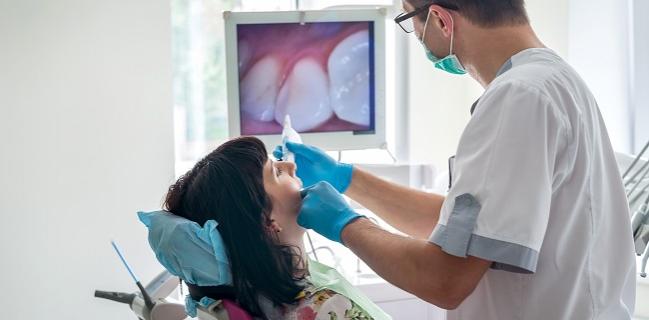Study Suggests Periodontitis May Be a Marker of Hypertension
Adults with versus without severe gum disease were twice as likely to have systolic blood pressures of 140 mm Hg or higher.

Periodontitis may be an unrecognized marker for hypertension in otherwise healthy individuals, according to data from a British registry that found those with serious gum disease were more likely than those with healthy gums to have elevated systolic and diastolic BP.
At a minimum, the link opens another avenue for identifying people whose elevated blood pressure may be undiagnosed or uncontrolled, experts say.
Adults in the study who had periodontitis—defined as severe and chronic gingival inflammation with associated alveolar bone loss—were more than twice as likely to have systolic pressures of 140 mm Hg or higher and about 50% more likely to have diastolic pressures of 80 mm Hg or higher compared with healthy controls.
“This study expands current knowledge on the association between periodontitis and elevated BP, pointing at the importance of this link in the generally healthy population,” Eva Muñoz Aguilera, DDS (UCL Eastman Dental Institute, London, England), and colleagues write in Hypertension. “Oral health professionals could play a pivotal role in helping the medical community detecting and tackling the burden and consequences of hypertension.”
Commenting on the study for TCTMD, Sidney C. Smith Jr, MD (University of North Carolina at Chapel Hill), said it raises important issues about the association between periodontal disease, hypertension, and inflammation. Given that the median age of patients was mid-30s, he agreed that dental exams could be an important and overlooked health contact where information such as blood pressure can be readily obtained and shared.
“It certainly should lend support to the importance of closer collaborative working relationships between the dentist, cardiologist, internist, and others who are responsible for the patient's medical care,” he added.
Oral Health and Elevated BP Associations
Aguilera and colleagues studied 250 adults diagnosed with severe periodontitis based on a full-mouth periodontal assessment, as well as a control group of 250 adults without severe gum disease or chronic health conditions. The median age of participants was 35 years, and 52.6% were women. Blood pressure was taken three times for each participant. To look for inflammation, fasting blood samples were collected and analyzed for white blood cell count and high-sensitivity C-reactive protein (hsCRP).
Systolic BP ≥ 140 mm Hg was seen in 14% of those with periodontitis versus 7% of controls (P = 0.021). Similarly, diastolic BP ≥ 80 mm Hg was seen in > 43% of cases versus 34% of controls (P = 0.035). By the European hypertension guidelines (≥ 140/90 mmHg), 17.2% of cases and 14% of controls fell within the hypertensive range (P = 0.324), while by the American definition (≥ 130/80 mmHg) almost 50% of cases and a 41.6% of controls fell within the hypertensive range (P = 0.073). Even among those with generalized gum bleeding, systolic BP was about 5 mm Hg higher than in those with non-bleeding gums (P = 0.002).
There is an association here between periodontal disease and hypertension that's very important for patient care and also should be a stimulus for further research into possible causal relationships. Sidney Smith
Additionally, compared with controls, those with periodontitis had higher glucose and LDL levels and lower HDL levels. No associations were seen between elevated systolic or diastolic BP and white blood cell counts or hsCRP. After adjustment for age, body mass index, sex, ethnicity, smoking, physical activity, and family history of CVD, greater severity of periodontitis was associated with higher mean systolic BP.
Aguilera and colleagues note that they did not account for other confounders that might affect blood pressure, such as abdominal obesity, salt intake, use of anti-inflammatories or hormone treatments, stress, or other types of oral health problems.
Stimulus for Further Research
Although the overall data on periodontitis and hypertension are scarce, the study builds on several other studies, including one that found an association between periodontal disease and brachial artery endothelial dysfunction as well as systemic inflammation. Additionally, NHANES III data have shown associations between gingivitis and increased systolic BP and uncontrolled high BP, Aguilera and colleagues write.
According to the researchers, among the underlying reasons why periodontal disease might lead to elevated BP are low-grade systemic inflammation and oxidative stress triggered by the bacteria causing the gum damage. While the current study did not show hsCRP or white blood cell count as a proxy of systemic inflammation to be associated with elevated BP, other studies have found a connection, Aguilera and colleagues add, suggesting that the young age of this particular study population could explain why there was no association,.
Smith said that although the study is well done and includes an ethnically diverse sample, there remain factors that are important contributors to hypertension but may not have been accounted for.
“It's very important to pay attention to the comorbidities that may be present in patients with periodontal disease, such as diabetes and metabolic syndrome,” he said. “But there is an association here between periodontal disease and hypertension that's very important for patient care and also should be a stimulus for further research into possible causal relationships.”
L.A. McKeown is a Senior Medical Journalist for TCTMD, the Section Editor of CV Team Forum, and Senior Medical…
Read Full BioSources
Aguilera EM, Suvan J, Orlandi M, et al. Association between periodontitis and blood pressure highlighted in systemically healthy individuals: results from a nested case-control study. Hypertension. 2021;Epub ahead of print.
Disclosures
- Aguilera and Smith report no relevant conflicts of interest.




Comments